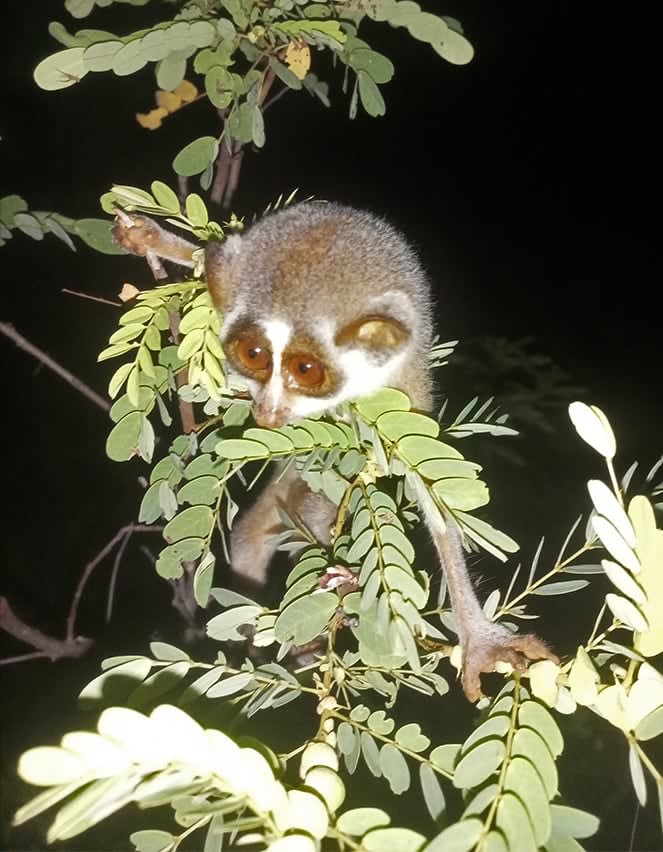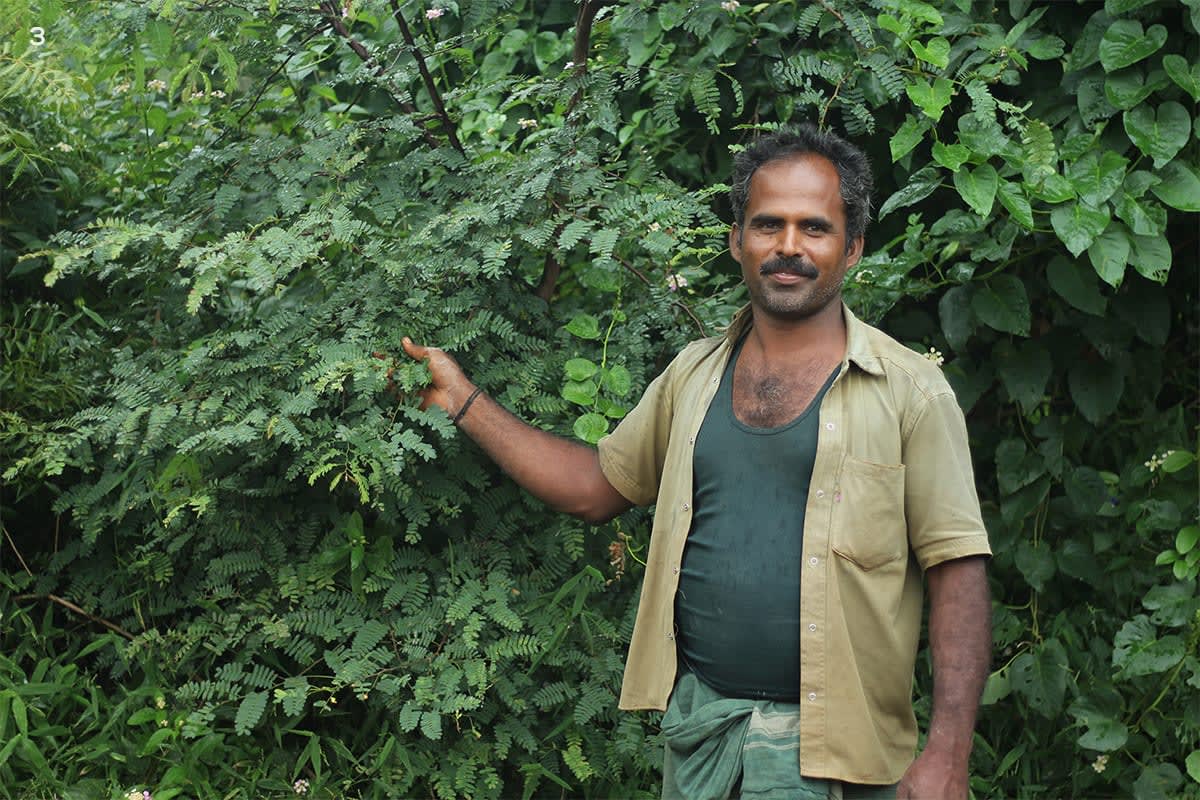 Listen to this article
•
15:34 min
Listen to this article
•
15:34 min
Tucked amidst lush green hills, Panchanthangi, a hamlet in Dindigul district, Tamil Nadu, is remote, and nearly inaccessible. For four generations, Kanagaraj and his neighbours have lived a quiet life, uninterrupted by the humdrum of the modern world. “Our families have lived here for close to 200 years,” says the 40-year-old. He recalls going on honey-hunting trips to the neighbouring hills with his grandfather at the age of five. “We used to collect pondhu thaen (honey found in tree hollows), kombu thaen (honey found at high altitudes) and thodu thaen (honey found inside rock cavities).” His favourite childhood memory is digging up tubers and picking wild fruits. While the traditional honey-hunting practice has declined to a large extent, the current generation still goes to the hills to pick turkey berries, tubers and herbs, which they use for both food and trade.
Apart from foraging, most residents in Panchanthangi engage in small-scale farming and livestock rearing. Kanagaraj has a small vegetable farm and rears close to 40 sheep. He points out a nearby hillock where they have gone grazing. With inconsistent rains and the impacts of climate change, farming has become tough for the villagers, with most residents relying on livestock for their income.
With the Kadavur Slender Loris Sanctuary spanning across 11,806 hectares being notified recently, villages in the vicinity including Panchanthangi are apprehensive about how it might impact their lives and livelihood.

Cover photo: Shankar, a farmer who lives in Panchanthangi. Photo by Balasubramaniam N.
Slender loris population trends in the past
The hamlet harbours a love-hate relationship with the elusive mammal. As the locals know the hills and forests like the back of their hand, they were adept in tracking the slender loris. Some had even unwittingly become a part of a poaching network in the past.
The non-profit SEEDS Trust began work for the slender loris conservation with the forest department and local community. “The slender loris is an important pollinator and an indicator species. If we save it, we save the entire habitat,” says Muthusamy, Founder of SEEDS Trust. “However, we felt that we should conserve it along with the livelihood of the people dependent on the forests.”
From killings, poaching and pesticide poisoning to harsh droughts and deforestation, causes were aplenty for the decline of the slender loris. While there were simple fixes like installing speed breakers in accident zones, creating awareness about the slender loris was the main challenge.
Muthusamy reveals that they began extensive programmes in schools and colleges to ensure that the next generation is sensitised towards their environment and the slender loris. “We had supported the education of several first-generation learners and they in turn were our slender loris ambassadors – creating awareness about slender loris and its conservation to their peers and families.”
The role of women in community conservation
With children on board, the next step was to onboard women involved in Non-Timber Forest Produce (NTFP) collection. In Sukkavalli, a neighbouring town, a group of women were hurrying downhill with their livestock, some carrying twigs for their stoves, and grasses to make brooms. While most of them were unaware of the notification of the sanctuary, they all knew about the loris.
Muthulakshmi, age 50, told Mongabay-India that the devangu (slender loris) comes down from the hills to visit their farms and trees in the night. “We call the slender loris as iravaadi (night-feeding creatures) as it feeds in the night.”
They guessed it was here to feast on the mealy bugs found in their farms. “The moderate climate of the region is also suitable for these tiny mammals and that is why they seem to thrive in this region,” informs Iyyapan who has been involved in slender loris conservation for the last eight years. Muthulakshmi agrees. “There was a time when we considered this slender loris as a sign of ill-luck but we now know how it helps our farmers by getting rid of our pests naturally. In fact, we now consider it as our pride.” Every other household in Sukkavalli has paintings of the loris on its walls, thanks to efforts of local NGO SEEDS Trust.
Muthulakshmi and her group have played a major role in afforestation efforts in the region. They planted over a lakh (100,000) native tree saplings with the help of NGOs which helped improve the habitat – an increase in rainfall too was witnessed, a win-win for locals and the loris.
What the notification means for the local community
Iyyapan says that apart from afforestation efforts in wastelands and village commons, local farmers have been involved in agro-forestry too. Ramesh Kumar and his entire family including his 90-year-old father Shankar were working in their ancestral farm when we arrived. From commercial trees to fodder plants and fruit trees, his paddy farm was juxtaposed with trees that provided a source of income and food for his family and habitat for the loris. Ramesh and his neighbours are also steadily shifting to organic farming to avoid accidental poisoning. “We now use the green manure which we collect from the hills when our cows go grazing,” says Ramesh. But what happens if the locals are banned from grazing or visiting the newly declared reserve?
“Ours is vanam partha poomi (translates as land that is dependent on the skies). As rainfall becomes unpredictable each year, even farmers here often rely on their livestock for survival and livestock in turn are dependent on the hilly pastures. From our food, fodder to festivals, our entire life revolves around these forests. If denied access to these forests, we would have no choice but to sell our cattle and migrate away from our ancestral lands,” worries Kanagaraj.
With the Madras High Court banning cattle grazing in tiger reserves, sanctuaries and national parks (a total of 8,102 sq. km. of Protected Areas) this year, it remains to be seen how the newly declared slender loris reserve would impact the livelihood of locals.
Post India’s push for the global goal of protecting 30 percent of earth by 2030, there’s been a substantial expansion of Protected Areas across the country and with it, a rise in conflict for forest rights. V.P. Gunasekaran is a social activist who has been fighting for tribal rights in the Satyamangalam district of Tamil Nadu and has witnessed conflict first-hand. He expresses his concerns that inevitable eviction of natives or denial of their access to forest lands will only lead to industrialisation. “From whom are we protecting these forests? It is enough if people from the plains do not enter these regions. There is no need to relocate people who belong in the forest and create barriers between people and forests,” he quips. Conservationists have even highlighted the importance of grazing in the prevention of forest fires and biodiversity loss.
Elaborating further on the ground scenario in this particular instance, Muthusamy says, “In the Western Ghats, there is considerable distance between two tribal villages whereas the people, livestock and wildlife share the same landscape – a village, a hillock, a forest patch, private farmlands – everything overlaps with one another. People have used this region as a whole, be it for food or livelihood. So, there might be some conflicts after the declaration of sanctuary,” and adds, “But there is no forest without its people. It would be prudent to get locals involved in conservation and set the regulations for the sanctuary accordingly.”

However, Supriya Sahu, Additional Chief Secretary of Environment, Climate Change and Forests Department, Government of Tamil Nadu, clarifies that there will be no new restrictions inside the new sanctuary. “We hope to set a management plan with people at its heart,” she says. As their initial plan is to map degraded spaces and restore original forest habitats, she believes that it will create new opportunities for locals to also be part of its afforestation efforts and maintenance such as removal of invasive species. With conflicts a common challenge in Protected Areas across Tamil Nadu, clear communication on community rights and roles could help allay the fear of locals.
“The fact is that people are already treating it as a sanctuary. There’s been no poaching activity in the last two years and the locals do not allow any outsiders to poach as well,” says Iyyapan. Even as the veteran farmer Shankar points to the trees that the slender loris prefers in his farm, he smiles nonchalantly, “The forest officers can patrol only along the streets. It is we who know what is happening inside the forest. As long as we are here, no one can harm our land. We belong to the hills and the hills belong to us.”
This story was first published in Mongabay India











